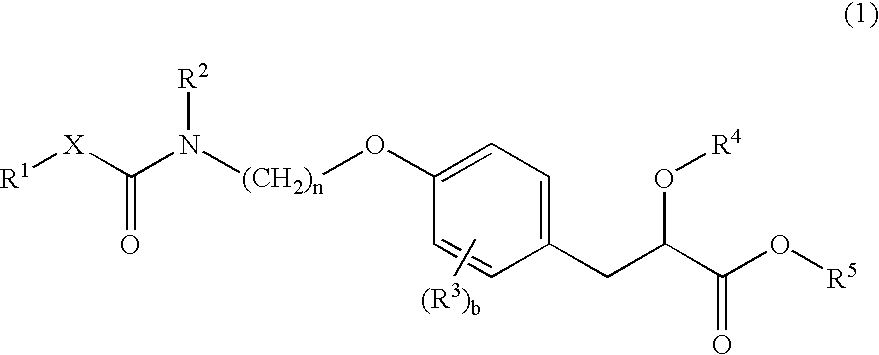Propionic acid derivatives
a technology of propionic acid and derivatives, applied in the field of propionic acid derivatives, can solve the problems of inconvenient preparation of insulin, adverse effect of severe hypoglycemia, and considerable problems of troglitazone, so as to reduce the action of total cholesterol, reduce blood glucose, and reduce the effect of triglycerid
- Summary
- Abstract
- Description
- Claims
- Application Information
AI Technical Summary
Benefits of technology
Problems solved by technology
Method used
Image
Examples
example 1
Synthesis of 3-(4-{2-[3-(2,4-difluorophenyl)-1-heptylureido]ethoxy}phenyl)-2-ethoxypropionic acid ethyl ester
Step a: Synthesis of [2-(4-formylphenoxy)ethyl]carbamic acid t-butyl ester
[5574]A solution of t-butyl N-(2-hydroxyethyl)carbamate (2.1 g, Aldrich) in pyridine (20 ml) was added dropwise with methanesulfonyl chloride (1.2 ml) and stirred at room temperature for 1 hour. The reaction mixture was diluted with methylene chloride and washed successively with water, aqueous sodium hydrogencarbonate, and saturated brine, dried over magnesium sulfate, and then concentrated to obtain a mesylate derivative. Separately, a solution of p-hydroxybenzaldehyde (1.59 g, Tokyo Kasei Kogyo) in dimethylformamide (DMF, 20 ml) was added with sodium hydride (572 mg, 60% dispersion in oil, Wako Pure Chemical Industries) under ice cooling and stirred for 10 minutes at room temperature. Then, this reaction mixture was added with a solution of the aforementioned mesylate derivative in DMF (20 ml) and st...
example 2
Synthesis of 3-(4-{2-[3-(2,4-difluorophenyl)-1-heptylureido]ethoxy}phenyl)-2-ethoxypropionic acid
[5586]A solution of the compound obtained in Example 1, Step f (40 mg) in ethanol (2 ml) was added with 1 N aqueous sodium hydroxide (0.1 ml) and stirred at room temperature for 2 hours and then at 50° C. for 1 hour. The reaction mixture was added with 1 N hydrochloric acid (0.1 ml) and concentrated, and the resulting residue was applied on a silica gel column and eluted with methylene chloride / ethanol (10:1, containing 1% acetic acid) to obtain the title compound (35.6 mg).
[5587]1H-NMR (CDCl3) δ ppm (300 MHz): 8.0 (m, 11H), 7.51 (brs, 1H), 7.18 (d, 2H, J=8.6 Hz), 6.8–6.9 (m, 3H), 4.0–4.2 (m, 3H), 3.3–3.8 (m, 6H), 2.9–3.1 (m, 2H), 1.1–1.3 (m, 13H), 0.9 (m, 3H)
example 3
Synthesis of 3-(4-{2-[3-(2,4-dimethoxyphenyl)-1-heptylureido]ethoxy}phenyl)-2-ethoxypropionic acid
[5588]A solution of the compound obtained in Example 1, Step e (57.3 mg) in methylene chloride (4 ml) was added with 2,4-dimethoxyphenyl isocyanate (54 μl, Aldrich) and stirred for 1 hour. The reaction mixture was added with a polyamine resin (100 mg, prepared by the method described in J. Am. Chem. Soc., 119, 4874–4881, 1997), further stirred for 1 hour and filtered, and the filtrate was concentrated. The resulting residue was dissolved in ethanol (2 ml), added with 1 N aqueous sodium hydroxide (0.2 ml) and stirred at 50° C. for 2 hours. The reaction mixture was cooled to room temperature, added with 1 N hydrochloric acid (0.2 ml) and concentrated. The resulting residue was dissolved in methylene chloride and washed with 1 N hydrochloric acid. The solution was dried and concentrated, and the resulting residue was applied on a silica gel column and eluted with hexane / acetone (2:1, conta...
PUM
 Login to View More
Login to View More Abstract
Description
Claims
Application Information
 Login to View More
Login to View More - R&D
- Intellectual Property
- Life Sciences
- Materials
- Tech Scout
- Unparalleled Data Quality
- Higher Quality Content
- 60% Fewer Hallucinations
Browse by: Latest US Patents, China's latest patents, Technical Efficacy Thesaurus, Application Domain, Technology Topic, Popular Technical Reports.
© 2025 PatSnap. All rights reserved.Legal|Privacy policy|Modern Slavery Act Transparency Statement|Sitemap|About US| Contact US: help@patsnap.com



